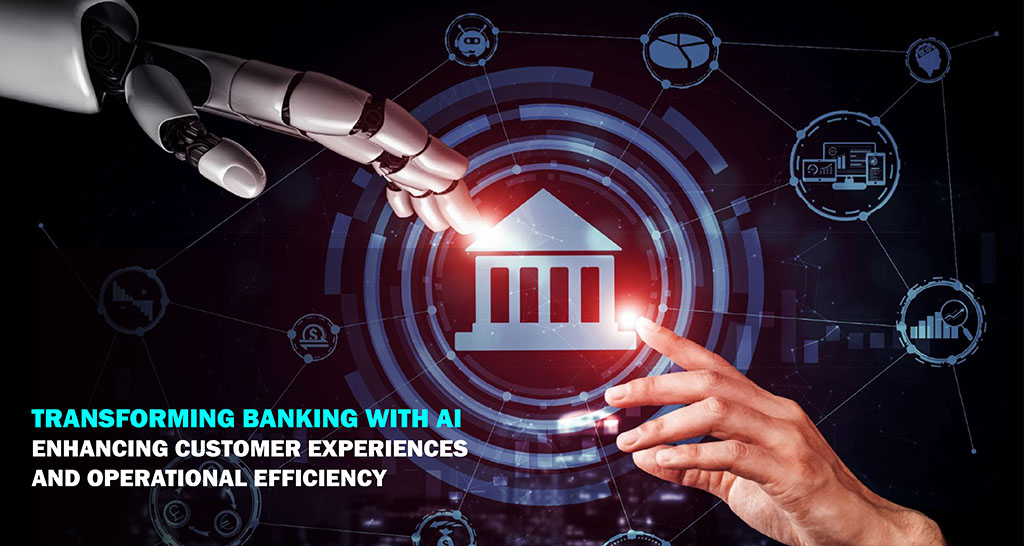In the dynamic world of banking and finance, artificial intelligence (AI) integration has emerged as a driving force. It is transforming traditional models and restructuring how financial institutions engage with customers. From strengthening cybersecurity to revolutionizing customer service, AI applications in banking demonstrate diverse capabilities. They enable remarkable advancements in operational efficiency and customer-focused approaches. This discussion explores how AI is transforming the banking sector. It sheds light on various ways AI is improving customer experiences and operational processes.
The Evolution of AI in Banking
Artificial intelligence has deeply entered the core operations of banking institutions, giving them advanced abilities to strengthen security measures and simplify complex processes. Additionally, AI allows banks to offer personalized services suited to individual preferences more efficiently and accurately.
The range of AI applications in banking includes a variety of functions:
- Cybersecurity and Fraud Detection: With increased digital transactions, AI-driven systems are crucial in strengthening cybersecurity measures. They quickly detect and reduce fraudulent activities in real time. Using complex algorithms, banks can spot unusual patterns, track potentially harmful behavior, and prevent cyber threats with great success.
- Chatbots: AI-powered chatbots act as virtual assistants, providing customers with 24/7 support and personalized recommendations. They streamline assistance for various banking queries. By using the power of Natural Language Processing (NLP), these chatbots effectively understand and respond to customer inquiries. This significantly improves the overall user experience.
- Loan and Credit Decisions: AI algorithms carefully analyze large sets of information to evaluate whether someone is likely to repay a loan. This helps banks make informed lending decisions based on factors beyond regular credit scores. By closely examining behavioral patterns and transaction records, AI-driven systems reduce risks and improve the loan approval process with unmatched accuracy.
- Predictive Analytics: AI enables predictive analytics, allowing banks to forecast market trends and identify profitable investment opportunities. It also helps them navigate risks wisely. By carefully analyzing large volumes of data, AI algorithms provide valuable insights that support strategic decision-making efforts. This enhances profitability and resilience in an unpredictable landscape.
- Process Automation: Robotic Process Automation (RPA) is essential for achieving operational efficiency. It streamlines repetitive tasks like data entry and document processing through automation. It simplifies work processes and improves productivity within organizations. By using AI-powered automation, banks simplify work processes and improve resource allocation. This leads to a new operating approach with increased effectiveness and fewer errors.
Examples of AI Implementation in Banking
Leading banking institutions worldwide have eagerly taken up AI technologies, igniting a transformative wave beyond traditional boundaries and encouraging innovation. This enthusiastic acceptance of AI is driving the banking industry into a new era of efficiency and creativity.
Notable examples include:
- JPMorgan Chase: JPMorgan Chase leads in AI integration, using advanced deep learning techniques to detect cyber threats early. Their proactive strategy helps predict and prevent potential security problems effectively.
- Capital One: Capital One leads in innovation in customer engagement with Eno, an AI-powered virtual assistant. Eno enhances customer interactions and fights credit card fraud with innovative solutions like virtual card numbers.
- European Bank (Anonymous): This European bank has experienced a significant increase in customer retention and satisfaction by implementing an AI-based chatbot assistant. Real-time query resolution enhances the overall banking experience tremendously.
Navigating Challenges in AI Adoption
Even though AI can change banking significantly, banks face many challenges when using it smoothly. Some of these challenges include:
- Data Security Concerns: Protecting sensitive customer data from breaches and cyber threats is a top priority, requiring strong security measures. This involves implementing robust security protocols and strict compliance measures.
- Challenges with Data Quality: Access to organized, high-quality data is necessary for effectively training AI models. However, many banks face challenges such as data systems and differences in data that slow down their progress.
- Transparency Imperatives: Ensuring transparency and explainability in AI-driven decision-making is crucial. It builds trust and reduces risks linked to unfair algorithms.
What Banks Need to Do
In the search for sustainable growth and competitive advantage, banking institutions must adopt an AI-first mindset. This approach is crucial for guiding through the challenges of the digital era. Several strong reasons support the reason for this important decision:
- Unlocking Value: The potential of AI to unlock value for banks is huge. McKinsey suggests that AI technologies could add up to $1 trillion of extra value each year for the global banking sector. AI empowers banks across various uses to increase revenues, cut costs, and discover new opportunities through data-driven insights. This helps them enhance their operations and stay competitive in the market.
- Meeting Customer Expectations: In today’s highly digitalized era, consumers expect seamless, personalized experiences from their service providers. These expectations are rising as technology advances. Using AI, banks can provide personalized services and predict customer needs, offering timely support. This enhances customer satisfaction and loyalty.
- Overcoming Competitive Threats: The banking world is changing a lot because of new companies using AI in finance. This includes both small fintech startups and big tech companies. To stay important and competitive, banks need to prioritize using AI. They can do this by using advanced technologies to encourage innovation and stand out from others.
- Addressing Operational Challenges: Despite AI’s transformative power, banks face various operational challenges. These challenges cover strategic, technological, and cultural aspects. To overcome these obstacles, institutions need to coordinate a comprehensive transformation effort. This involves creating a clear vision, improving technological infrastructure, and fostering a culture of innovation and collaboration.
In conclusion, for banks to move towards a future where AI comes first, they need to focus on being innovative, adaptable, and forward-thinking. By using AI to its full potential, banks can go beyond normal limits, strengthen customer relationships, and keep growing steadily in a changing world. As AI becomes more important, the banking industry is ready to change itself, leading to a new era of innovation, effectiveness, and putting customers first.

